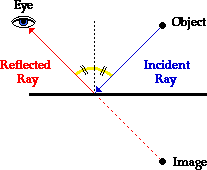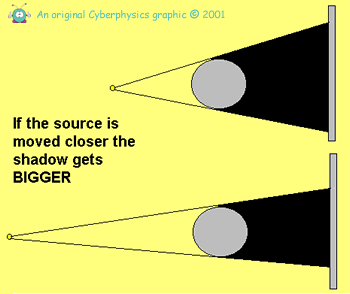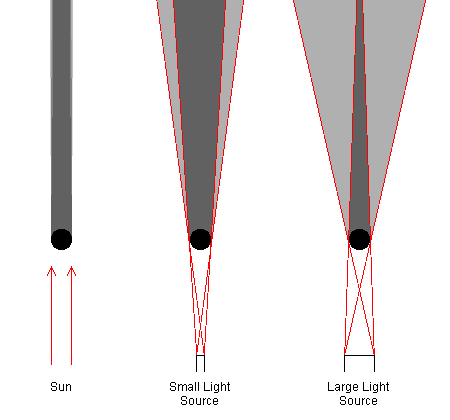A fundamental property of light is that it travels in a straight line as long as it is moving through the same medium (the substance through which light is travelling). A laser beam is an excellent example representing that light travels in a straight line. Light behaves differently when it strikes a mirror or lens because it reflects or refracts.
Evidence that light travels in straight lines is that you never see a flashlight beam go around a corner.
Luminous objects (objects that emit light) radiate light in all directions. An example of a luminous object is a candle because a candle will illuminate all objects surrounding it in a complete sphere. The example of a candle can also be used to represent the Ray Model of Light which was created by the fact that light always travels in straight lines.
|
Light ray: a straight line on a diagram representing the path that light waves are travelling in with the arrowhead of the ray showing the direction in which light waves are travelling.
The candle radiating light in all directions can be represented by drawing several light rays coming from the candle. There would be an infinite number of light rays coming from the candle, but we can simply draw a few to represent them. A bundle of rays is called a beam.
Ray diagrams are drawings that show the path that light takes after it leaves its source. Ray diagrams can help explain why the brightness of a light changes with distance. The more rays that reach your eyes, the brighter the object appears.
Geometric optics: the use of light rays to determine how light behaves when it strikes objects.
Incident light: light emitted from a source that strikes an object.
An example of incident light is light emitted from a source (the Sun) that strikes an object such as Earth.
Types of Media
Types of Media
Matter can be classified into three categories, depending on how it behaves when light strikes it. All substances may be classified according to how they transmit, reflect, and absorb light.
Transparent objects: when a material transmits all or almost all incident light; objects can be clearly seen through the material
- Lets light pass through it easily
- Allows objects behind it to be seen clearly
- Transmit most of the light they receive and reflect very little light
- can be either clear or coloured
- Examples include: clear glass, clear window pane, sunglasses, clear bottle and coloured plastic
- Allows some light to pass through
- Does not allow you to clearly see objects behind it
- Transmit most of the light, but the light is scattered
- Scattering occurs when light moves in different directions
- Examples include: tissue paper, frosted glass, tinted car windows, clouds and waxed paper
Opaque objects: when a material does not transmit any incident light; all incident light is either absorbed or reflected; objects behind the material cannot be seen at all
- Does not allow any light to pass through it, the light is only absorbed
- It is not possible to see objects behind opaque materials
- Examples include: aluminum foil, concrete brick, chocolate milk, pen, rock, metal and wood
Flat Mirrors
Mirror: any polished surface reflecting an image.
Image: reproduction of an object through the use of light.
Reflection: the bouncing back of light from a surface.
Most mirrors consist of glass at the front and the thin layer of reflective silver or aluminum at the back. Learn how mirrors work here.
 |
| The breakdown of a mirror |
The reflective part of the mirror is the thin film on the back. The glass protects the thin film and aids in the physical appearance of the mirror. The symbol that is used in physics to represent a mirror refers only to the reflective thin film.
The Terminology of Reflection
 |
| The terminology of reflection diagram |
A plane mirror, or a flat mirror, shows how predictable the path of light is when it hits the mirror. The original incoming ray is called the incident ray. The ray that bounces off the mirror is called the reflected ray. The normal line is perpendicular (at right angles) to the mirror. The normal is drawn at the point where the incident ray strikes the surface of the mirror. The angle of incidence is the angle between the incident ray and the normal and the angle of reflection is the angle between the reflected ray and the normal. For a video further explaining these terms, click here, and start the video at 1:40 seconds.
Plane: flat
Incident ray: the incoming ray that strikes a surface.
Reflected ray: the ray that bounces off a reflective surface
Perpendicular: at right angles
Angle of incidence: the angle between the incident ray and the normal
Angle of reflection: the angle between the reflected ray and the normal
 |
Shadows
Shadow: a dark region that forms behind an object that is being illuminated more brightly on one side than on any other.
Shadows are formed when some or all light falling on an object is absorbed or reflected by it. A shadow is the result when an opaque object blocks the direct light from a light source. Ray diagrams help to explain the size and location of shadows and why some shadows are sharp and well defined while other shadows have less distinct edges.
The size of a shadow depends on the size of the object blocking the source of light and the distance of the blocking object from the light source. The further the object is from the light source the smaller the shadow.
Larger the distance, smaller the shadow.
A small light source will cast a shadow that is sharp and well defined.
If the light source is large in comparison to the object blocking the light, the shadow will not have a sharp edge.
Penumbra: Region where some or all of the light source is obscured.
Umbra: Darkest part of the shadow.
|





No comments:
Post a Comment